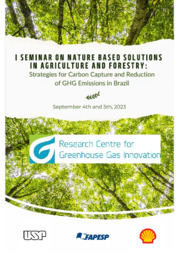N2O emission factors for nitrogen fertilizers and animal excreta in pastures: a meta-analysis for Brazil.
N2O emission factors for nitrogen fertilizers and animal excreta in pastures: a meta-analysis for Brazil.
Author(s): PENTEADO, L. F.; NOGUEIRA, S. F.; ANDRADE, C. A. de; RAMOS, N. P.; PAZIANOTTO, R. A. A.; GAROFALO, D. T.
Summary: Between 1985 and 2020, Brazil increased its pasture area by 38%, from 111 to 154 million hectares. In turn, N2O emissions from the agriculturallivestock sector in 2016 accounted for 87% of the total emissions of this gas in the country. The determination of N2O EF in national inventories is carried out using the values recommended by the IPCC, but there are limitations, since a default N2O EF is used for diverse nitrogen fertilizers, in different situations of livestock practices and edaphoclimatic conditions. This standardization of the EF, mainly for a country like Brazil with continental dimensions and with great edaphoclimatic diversity, can lead to future mistakes in the dimensioning of the N2O emissions caused by national livestock. Therefore, this review and metaanalysis study aimed to propose consistent and reliable N2O EFs for each type of nitrogen fertilizer and animal excreta in pastures in Brazil. The selection of studies was carried out through a systematic review by consulting the databases of online scientific articles: Web of Science, Scopus, and Scielo from December 2018 to August 2022. The queries used the search syntaxes: “Brazil” and “nitrous oxide emission” and “emission factor” and “pasture”, “pasturelands”, “grasslands”, “livestock”, and 20 articles were considered suitable for analysis, which had information about the EFs or experimental conditions that allowed the calculations of the EFs. The meta-analysis was performed using the methodology without weighting for variance, where the means and 95% confidence intervals for the EF were estimated using the bootstrap non-parametric resampling method. The mineral fertilizers evaluated in the studies were urea, ammonium nitrate, and ammonium sulfate presented EFs and confidence intervals (%) of 0.57 [0.46-0.68]; 1.16 [0.51-1.81] and 0.28 [0.13-0.43], respectively. As for animal excreta, results were found regarding feces, urine, and feces plus urine of 0.14 [0.12-0.16]; 0.75 [0.63-0.87]; 0.59 [0.34-0.84], respectively. The average value found for EFs from mineral fertilizers was 0.69 and from animal excreta was 0.48 compared to the default value of 1% by the IPCC. It is concluded that the values offered by the IPCC in relation to the N2O EF would overestimate the real values found in Brazilian pastures.
Publication year: 2023
Types of publication: Abstract in annals or event proceedings
Unit: Embrapa Environment
Keywords: Greenhouse gases, Livestock, Meta-analysis, Mitigation
Observation
Some of Embrapa's publications are published as ePub files. To read them, use or download one of the following free software options to your computer or mobile device. Android: Google Play Books; IOS: iBooks; Windows and Linux: Calibre.
Access other publications
Access the Agricultural Research Database (BDPA) to consult Embrapa's full library collection and records.
Visit Embrapa Bookstore to purchase books and other publications sold by Embrapa.

